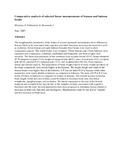| dc.description.abstract | The morphometric parameters of the brains of several mammals and primates show differences that are likely to be associated with cognitive and other functions necessary for survival as well as evolution. Seven human and eight baboon formalin-fixed brains were used to show comparative aspects. The whole brains were weighed, 3 from humans and 3 from baboons were separated into components -cerebrum, cerebellum and brainstem- and their weights were recorded. The linear measurements of the cerebrum were occipito-frontal (O-F), fronto-temporal (F-T) temporo-occipital (T-O), height of temporal lobe (HTL), inter: frontal pole (F-F), occipital pole (O-O), parietal (P-P), temporal pole (T-T), and occipital lobe (OL-OL) from superior, lateral and inferior aspects. The proportions of brain weight relative to body weight and those of the brain components were mostly higher in the humans. The length, height and width of the human brains were higher than in the baboons. F-F was six times O-O in humans while other parameters were nearly double in humans as compared to baboons. The ratio of P-P to F-F was nearly 20 times in baboons as compared to 6 times in humans. The overall increase in human brain length, width and size of lobes could be related to increased body size, functional complexity, upright posture, and evolution. The lateral expansion in the size of the frontal, temporal and occipital lobes may be due to the complex circuitry associated with cognitive functions and life style. Several approaches have been proposed to determine factors related to increases in brain size, function and intelligence. Morphometry could be one tool to "explain" specific increases in brain areas. | en |



